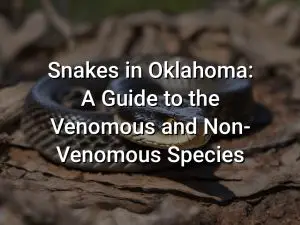Snakes in Arizona: A Guide to Safety and Identification

When it comes to snakes, Arizona is home to a diverse range of species, including venomous and non-venomous types. Whether you’re a hiker, resident, or simply curious about the reptiles in this southwestern state, it’s crucial to have a guide to safety and identification. In this article, we’ll provide you with essential information on the venomous snakes found in Arizona, as well as the non-venomous species that call this region home.
From the feared Rattlesnake to the colorful Coral Snake, Arizona’s snake population offers a fascinating insight into the state’s wildlife. We’ll explore the characteristics, habitat, and safety measures associated with each species, including the Arizona Black Rattlesnake, Sidewinder Rattlesnake, and the Gopher Snake. Whether you’re interested in learning more about these reptiles or want to stay safe during your outdoor adventures, our comprehensive guide has got you covered.
Quick Links
Venomous Snakes in Arizona
Arizona is home to several species of venomous snakes, including rattlesnakes and coral snakes. It is important to be able to identify these snakes and understand how to stay safe in their presence.
Rattlesnakes are the most commonly encountered venomous snakes in Arizona. They are easily recognized by the rattles on their tail, which they use as a warning to potential threats. Rattlesnakes can vary in color and pattern, but most have triangular-shaped heads and a pit between their eyes and nostrils. If you encounter a rattlesnake, it is important to give it plenty of space and avoid provoking it.
Coral snakes, although less common, are also venomous and should be avoided. They have distinctive red, yellow, and black bands that encircle their bodies. The saying “red touches yellow, kills a fellow; red touches black, venom lack” can help distinguish coral snakes from non-venomous look-alikes. If you see a coral snake, do not approach it or attempt to handle it.
If you come across a venomous snake in Arizona, it is best to leave it alone and give it space to retreat. Keep in mind that snakes are an important part of the ecosystem and help control rodent populations. If you are concerned about snakes on your property, consider implementing snake deterrent measures such as removing potential hiding spots and sealing off entry points.
Remember, if you are bitten by a venomous snake, seek immediate medical attention. Do not attempt to treat the snake bite yourself.
Non-venomous Snakes in Arizona
Arizona is home to a variety of non-venomous snakes that play an important role in our ecosystems. While they may not pose a threat to humans, it’s still important to be able to identify them to avoid any unnecessary alarm. Here are some non-venomous snakes you may encounter in Arizona:
- Gopher Snake: These snakes are often mistaken for rattlesnakes due to their similar appearance and defensive behavior of hissing and rattling their tails when threatened. However, gopher snakes are harmless and are actually beneficial as they help control rodent populations.
- Coachwhip Snake: These slender snakes are known for their incredible speed and agility. They are typically reddish or tan in color and can grow up to 6 feet long. Coachwhip snakes are non-venomous and primarily feed on small rodents and lizards.
- Kingsnake: Kingsnakes are known for their striking patterns and colors, which can vary depending on the subspecies. They are constrictors and feed on a variety of small animals, including other snakes. Kingsnakes are non-venomous and are often considered beneficial to humans due to their ability to control rodent populations.
It’s important to remember that even though these snakes are non-venomous, it’s best to observe them from a safe distance and avoid handling them unless you have the necessary experience and knowledge. If you encounter a snake in the wild, it’s always best to give it space and let it move on its own.
Coral Snakes
Coral snakes are venomous snakes that can be found in Arizona. They are often recognized by their distinctive color pattern of red, yellow, and black bands. The bands are arranged in a specific order: red touches yellow, kill a fellow; red touches black, venom lack.
It is important to note that coral snakes are not aggressive and typically try to avoid confrontation. They prefer to hide in underground burrows or leaf litter. However, if threatened or provoked, they may bite and inject their potent venom.
The venom of coral snakes is highly neurotoxic, meaning it affects the nervous system. Their bites can cause symptoms such as difficulty breathing, muscle weakness, and even paralysis. If you encounter a coral snake, it is essential to maintain a safe distance and avoid handling or provoking it.
If you believe you have been bitten by a coral snake, seek immediate medical attention. Do not attempt to treat the bite on your own. Antivenom is available to counteract the effects of coral snake venom, but it should only be administered by trained medical professionals.
Remember, prevention is key when it comes to snake encounters. Be cautious when walking in areas where snakes may be present, especially in tall grass, rocky areas, or near water sources. If you come across a snake, give it space and allow it to move away on its own. By being aware and informed, you can safely coexist with snakes in Arizona.
Rattlesnakes
Rattlesnakes are a group of venomous snakes that are found throughout Arizona. They are characterized by their rattles, which they use as a warning signal when they feel threatened. Rattlesnakes are known for their venomous bite, which can be potentially dangerous to humans and pets.
There are several species of rattlesnakes that are commonly found in Arizona, including the Arizona Black Rattlesnake, the Sidewinder Rattlesnake, and the Diamondback Rattlesnake.
The Arizona Black Rattlesnake, also known as the Western Diamondback, is one of the most common rattlesnake species in the state. It has a black or dark brown coloration with diamond-shaped patterns along its back. This species can grow up to 6 feet in length and has a venomous bite.
The Sidewinder Rattlesnake is a unique species that is well-adapted to the desert environment. It has a distinct way of moving, which involves a sideways motion that leaves a distinctive “sidewinding” track in the sand. This species is usually light brown or sandy in color and has small, horned scales above its eyes.
The Diamondback Rattlesnake is the most iconic species of rattlesnake in Arizona. It has a diamond-shaped pattern along its back and a rattle at the end of its tail. This species can grow up to 7 feet in length and is known for its aggressive behavior when provoked.
Encountering a rattlesnake can be a frightening experience, but there are steps you can take to stay safe. If you see a rattlesnake, it’s important to give it plenty of space and not try to handle or approach it. Keep a safe distance and slowly back away from the snake. If you are bitten by a rattlesnake, seek immediate medical attention as venomous bites can be life-threatening.
Remember, it’s important to be aware of your surroundings when hiking or spending time outdoors in Arizona. Stay on designated trails, wear protective clothing and footwear, and watch where you step or place your hands. By being cautious and informed, you can safely enjoy the beauty of Arizona while minimizing the risk of encountering a rattlesnake.
Arizona Black Rattlesnake
The Arizona Black Rattlesnake, also known as the Black Diamond Rattlesnake, is a venomous snake native to the region. It is characterized by its dark black coloration, which helps it blend in with its surroundings.
This species of rattlesnake is typically found in rocky areas, canyons, and desert foothills of Arizona. It prefers to hide in crevices and rocky outcrops during the day and becomes more active at night. The Arizona Black Rattlesnake feeds primarily on small mammals, such as mice and rats.
If you encounter an Arizona Black Rattlesnake, it is important to exercise caution. This species has venom that is potent and can cause harm to humans if bitten. If bitten, it is crucial to seek immediate medical attention.
To identify an Arizona Black Rattlesnake, look for the following characteristics:
- Length: Adults can reach up to 4-5 feet in length.
- Coloration: They have a solid black coloration with a distinct diamond-shaped pattern on their back.
- Rattle: Like other rattlesnakes, they have a rattle on their tail that they use as a warning signal.
- Head shape: They have a triangular-shaped head, which is a characteristic feature of venomous snakes.
If you come across an Arizona Black Rattlesnake, it is best to give it a wide berth and not disturb it. Remember, snakes play an important role in the ecosystem and should be respected from a safe distance.
Sidewinder Rattlesnake
The Sidewinder Rattlesnake is a venomous snake native to the deserts of Arizona. It is known for its unique method of locomotion, in which it moves sideways by using a sideways coiling motion. This distinct method of movement allows the snake to navigate efficiently through the loose sands of the desert.
The Sidewinder Rattlesnake is typically tan or light brown in color, with a series of dark brown or olive-colored patches along its back. It has a triangular-shaped head and a rattle at the end of its tail, which it uses as a warning signal when threatened.
Like other rattlesnakes, the Sidewinder has a venomous bite that can be dangerous to humans and other animals. If bitten by a Sidewinder Rattlesnake, it is important to seek immediate medical attention as soon as possible.
To avoid encounters with Sidewinder Rattlesnakes, it is recommended to stay on designated trails when hiking in desert areas and to be cautious when stepping over rocks or brush. Keep a safe distance from any snake you encounter and never attempt to handle or harass the snake.
Remember, snakes play an important role in maintaining the balance of ecosystems and should be respected and admired from a safe distance.
Diamondback Rattlesnake
The Diamondback Rattlesnake is one of the most well-known and venomous snakes in Arizona. It is easily recognized by the diamond-shaped patterns on its back and the distinctive rattles on its tail.
These snakes are usually found in desert and grassland areas throughout the state. They are primarily active during the warmer months and tend to seek shade during the hottest parts of the day.
The venom of the Diamondback Rattlesnake is highly potent and can cause severe symptoms if bitten. It is important to exercise caution and keep a safe distance if you encounter one in the wild.
If you are bitten by a Diamondback Rattlesnake, seek medical attention immediately. Symptoms of a venomous snakebite may include severe pain, swelling, and difficulty breathing.
It is important to remember that these snakes play a crucial role in the ecosystem and should not be killed or harassed. If you encounter a Diamondback Rattlesnake, give it space and allow it to go about its natural behavior.
Remember, when it comes to snakes in Arizona, always prioritize your safety and take necessary precautions to avoid snake bites.
Gopher Snake
The Gopher Snake is a common non-venomous snake found in Arizona. It is often mistaken for a rattlesnake due to its similar appearance and defensive behavior, but it is harmless to humans.
The Gopher Snake has a slender body and can grow up to 4-6 feet in length. It has a yellowish-brown or tan color with large dark brown or black spots along its back and sides. Its body is covered in smooth scales, and its head is slightly wider than its neck, giving it a distinctive look.
Gopher Snakes are often found in arid desert areas and grasslands, where they feed on small rodents, birds, lizards, and eggs. They are excellent climbers and can sometimes be seen in trees or bushes.
When threatened, Gopher Snakes will coil up their bodies, hiss, and vibrate their tails, imitating the behavior of a rattlesnake. However, they do not have rattles and cannot produce venom. If they feel cornered or provoked, they may strike, but these bites are typically harmless.
If you encounter a Gopher Snake in Arizona, it is best to leave it alone and admire it from a safe distance. Remember that Gopher Snakes play a valuable role in controlling rodent populations and are a vital part of the ecosystem.
Coachwhip Snake
The Coachwhip Snake, also known as the Masticophis flagellum, is a non-venomous snake species found in Arizona. It is known for its impressive speed, agility, and unique appearance.
The Coachwhip Snake gets its name from its long and slender body, which resembles a coach whip. It can range in length from 3 to 6 feet and has a thin head with large eyes and a slightly upturned snout.
This snake species is known for its exceptional speed and agility, which it uses to capture its prey. Coachwhip Snakes primarily feed on lizards, birds, small mammals, and other snakes. They are excellent climbers and can also be found on trees and bushes.
The Coachwhip Snake is typically tan or brown in color, with a lighter underside. It may also have darker-colored bands or blotches along its body. This camouflage helps it blend in with its surroundings and provides protection from predators.
Although the Coachwhip Snake is non-venomous, it may become defensive if threatened and can strike and bite if provoked. However, its bites are not venomous and are generally harmless to humans. It is important to remember that these snakes play a crucial role in maintaining the ecosystem’s balance and should be respected and observed from a safe distance.
If you encounter a Coachwhip Snake in the wild, it is best to admire it from afar and avoid any attempts to handle or disturb it. Appreciating these fascinating creatures from a distance ensures the safety and well-being of both humans and the snake.
Kingsnake
Kingsnakes are non-venomous snakes that are native to Arizona. They are known for their distinctive pattern of alternating colors and bands, which can vary depending on the species. Kingsnakes are typically black or brown with white or yellow bands, giving them a regal and striking appearance.
These snakes are constrictors, meaning they kill their prey by coiling their bodies around them and suffocating them. Kingsnakes have a diverse diet and are opportunistic feeders, consuming a variety of animals including rodents, birds, reptiles, and even other snakes, including venomous ones.
Kingsnakes are beneficial to the ecosystem as they help control populations of small mammals and venomous snakes. They are relatively docile and non-aggressive towards humans, but may bite if threatened or provoked. However, their bites are harmless and rarely result in any serious injuries.
If you encounter a kingsnake in the wild, it is best to observe from a distance and avoid any unnecessary interaction. Kingsnakes are an important part of Arizona’s reptile diversity and should be respected and admired for their role in the ecosystem.
Conclusion
Living in an area with a high population of snakes, such as Arizona, means it’s important to be aware of the different types of snakes and how to stay safe. By familiarizing yourself with the venomous snakes in the region, such as coral snakes and rattlesnakes, you can better protect yourself and your loved ones from potential bites.
Additionally, it’s important to remember that not all snakes in Arizona are venomous. There are also non-venomous snakes, such as the gopher snake, coachwhip snake, and kingsnake, which provide benefits by controlling rodent populations. By learning how to identify these different types of snakes and understanding their behaviors, you can coexist with them in a safe and respectful manner.
Overall, with proper knowledge and precautions, you can enjoy the outdoors in Arizona while minimizing the risks associated with encountering snakes. Stay informed, be cautious, and always respect the wildlife, and you can have a safe and enjoyable experience in this beautiful state.






